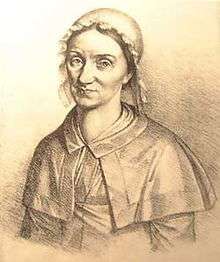Gesche Gottfried
Gesche Margarethe Gottfried, born Gesche Margarethe Timm (6 March 1785 - 21 April 1831), was a serial killer who murdered 15 people by arsenic poisoning in Bremen and Hanover, Germany, between 1813 and 1827. She was the last person to be publicly executed in the city of Bremen.

Psychiatric Profile
Gottfried was born into a poor family; she had a twin brother, Johann Timm, Jr. Her parents, Johann Timm and Gesche Margarethe Timm, always had a preference for her brother. The reasons behind Gottfried's crimes remain unclear and widely debated, but the emotional deprivation she suffered during her childhood and her modus operandi lead to the assumption that she suffered from Munchausen syndrome by proxy, a very common disorder among female serial killers.
Gottfried's victims included her parents, her two husbands, her fiancé and her children. Before being suspected and convicted of the murders, she garnered widespread sympathy among the inhabitants of Bremen because so many of her family and friends fell ill and died. Because of her devoted nursing of the victims during their time of suffering, she was known as the "Angel of Bremen" until her murders were discovered.
Modus operandi
She used a rat poison called "mouse butter" (in German "Mäusebutter") very common at the time, which consisted of small flakes of arsenic mixed in animal fat. She mixed small doses into her victims food, eventually they started to get sick and Gottfried "friendly, selfless and resignedly" offered to take care of them during their convalescence, while continuing to poison them.
During the period of her criminal activity, Gesche Gottfried was considered a model citizen and was well liked in the community. Even after the constant loss of relatives who suffered, it seemed that the friendly, candid and kind Gesche chased a "cloud of misfortune". Her neighbors, moved by the zeal and resignation with caring not only for her family but also her sick friends began to call her "the angel of Bremen".
Gesche Gottfried's victims
- 1 October 1813: Johann Miltenberg (first husband)
- 2 May 1815: Gesche Margarethe Timm (mother)
- 10 May 1815: Johanna Gottfried (daughter)
- 18 May 1815: Adelheid Gottfried (daughter)
- 28 June 1815: Johann Timm (father)
- 22 September 1815: Heinrich Gottfried (son)
- 1 June 1816: Johann Timm (brother)
- 5 July 1817: Michael Christoph Gottfried (second husband)
- 1 June 1823: Paul Thomas Zimmermann (fiancé)
- 21 March 1825: Anna Lucia Meyerholz (music teacher and friend)
- 5 December 1825: Johann Mosees (neighbor, friend and advisor)
- 22 December 1826: Wilhelmine Rumpff (landlady)
- 13 May 1827: Elise Schmidt (daughter of Beta Schmidt)
- 15 May 1827: Beta Schmidt (friend, maid)
- 24 July 1827: Friedrich Kleine (friend, creditor; murdered in Hanover)
Arrest, conviction and execution
Johann Christoph Rumpff, Gesche's would be twelfth victim, got suspicious after finding small white granules on food she had prepared for him. He confided to his physician, Dr. Luce, who, incidentally, had already attended several of the earlier victims and handed over the substance he had found. Luce determined that it was arsenic and alerted authorities, but by then Gottfried had already claimed two more victims and had moved to Hannover, where she was withering the life of her latest victim, Friedrich Kleine.
On the night of 6 March 1828, her 43rd birthday, she was arrested. She was sentenced to death by decapitation. She was publicly executed on 21 April 1831. It was the last public execution in the history of Bremen. Gottfried 's death mask was made to study the facial patterns of criminal women. This is within the now-obsolete field of study of phrenology.
Influences On Literature
In addition to her crimes, Gottfried inspired the creation and writing of several pieces of art and literature. One piece of art/literature that Gottfried inspired is a book by Sarah Bodeman called GIFT: I Made This For You.[1] Written in 2016, the art book is set up like a pamphlet with recipes. There are 14 recipes for each of Gottfried's victims. All of the food was cooked and photographed with the same ingredients and the same sequence of the original food that was made for Gottfried's victims. Another piece of literature that Gottfried inspired was a graphic novel titled “Gift” by Barbra Yelin.[2] The graphic novel is about Gottfried's story and her manner of poisoning her victims. Finally, in 2009 Susanne Kord wrote a book called Murderesses in German Writing, 1720-1860: Heroines of Horror.[3] In this book, the author discusses Gottfried and other woman murders, as well as how literature has portrayed these women. Despite her crimes, Gottfried will go down in history as not only committing fatal crimes, but influencing creative pieces of literature
References
- Bodman, Sarah (2016). Gift : I made this for you. Axminster, UK: Axminster Printing Company. OCLC 1064648843.
- Yelin, Barbara; Meter (2014). GIFT The Gesche Gottfried case - A historical drama. Berlin: Reprodukt. ISBN 3941099418.
- Kord, Susanne (2009). Murderesses in German Writing, 1720-1860: Heroines of Horror. Cambridge, England: Cambridge University Press. ISBN 9780521519779.
External links
- Gesche Gottfried in the German National Library catalogue
- Gesche Gottfried
- Detention House (in German)
- Gesche Gottfried in Stade (in German)
- Gesche Gottfried's death mask
- Article about the execution (in German)
- Willibald Alexis / Julius Eduard Hitzig: Kriminalfälle des neuen Pitaval - Gesche Margaretha Gottfried (in German)
- Effigy – Poison and the City (2019): historical thriller about the Gesche Gottfried case